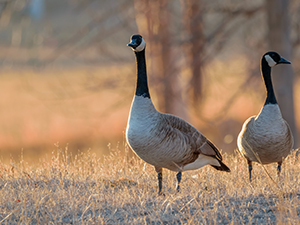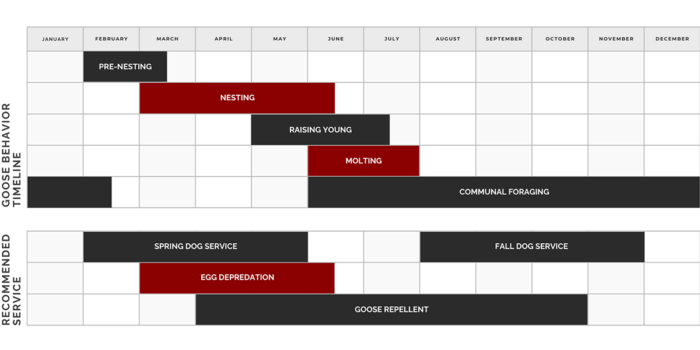Planning & Budgeting for Canada Goose Management
Jul 24, 2024
Canada geese pose problems for property owners year-round. Because goose behavior changes throughout the year, it can be hard to know which management approach should be used to deter geese – and when. When it comes to nuisance geese, there is no one-size-fits-all solution; rather, it is best to tailor your management approach to the time of year and the behavior geese exhibit during that time.
This blog outlines which goose management approach is most appropriate based on the time of year – and will help inform your property’s goose management budget.

February to May: Harassment
 In spring, geese migrate from the south to return to their breeding grounds and reconnect with mates or form new bonds. Geese that form pairs often return to previous nesting locations or, if those are not available, will look for a new location. Once found, they vigorously defend their territory from perceived threats, which can include humans. Once the pair has settled on a location, they will build their nest.
In spring, geese migrate from the south to return to their breeding grounds and reconnect with mates or form new bonds. Geese that form pairs often return to previous nesting locations or, if those are not available, will look for a new location. Once found, they vigorously defend their territory from perceived threats, which can include humans. Once the pair has settled on a location, they will build their nest.
During this time, a goose harassment service, like the one offered by Wild Goose Chase (WGC), is recommended. WGC’s service leverages a variety of harassment techniques, including trained border collies, handheld bird lasers, and remote-controlled boats, to reduce the presence of nuisance Canada geese on your property. Depending on your property’s needs, and the behavior of geese on your property, a single technique or combination of techniques may be used.
Geese are persistent, especially if they’ve previously successfully nested on your property – which means, for harassment to be effective, it must continue through the nesting season. To successfully discourage goose pairs from nesting on your property, WGC will conduct multiple service visits during each week of the nesting season.
March to May: Egg Depredation
 Starting in March, geese begin to lay eggs. The female will lay a clutch of six to eight eggs on average and incubate them alone while the male defends the nest from any perceived threats, which can include humans. Goslings hatch approximately 28 days after the female has finished laying her eggs. The family then leaves the nest and will often head to the closest body of water.
Starting in March, geese begin to lay eggs. The female will lay a clutch of six to eight eggs on average and incubate them alone while the male defends the nest from any perceived threats, which can include humans. Goslings hatch approximately 28 days after the female has finished laying her eggs. The family then leaves the nest and will often head to the closest body of water.
To help manage nuisance geese in the early spring, goose nest or egg management is recommended. WGC manages nests and eggs through its egg depredation service, which reduces the number of geese on your property and eliminates the hazards that nesting geese pose to human health and safety. Through this service, WGC will acquire the necessary federal and/or state permits and visit your property to manage nests and eggs in accordance with the permit(s), on an as needed or routine basis.
April to September: Goose Repellent
 If goslings hatch on your property, they will likely be a feature of your property through the late spring and summer. While goslings don’t need their parents to feed them, they are vulnerable to predators and need adult geese around to protect them. Therefore, adult geese stay near their young until they are old enough to fly, typically at about 10 weeks old. During this time, adult geese molt (or intentionally shed) their flight feathers. Before new flight feathers grow in, adult geese are flightless. Flightless adult geese and their offspring, who are still too young to fly, tend to form larger groups with other molting geese for increased protection.
If goslings hatch on your property, they will likely be a feature of your property through the late spring and summer. While goslings don’t need their parents to feed them, they are vulnerable to predators and need adult geese around to protect them. Therefore, adult geese stay near their young until they are old enough to fly, typically at about 10 weeks old. During this time, adult geese molt (or intentionally shed) their flight feathers. Before new flight feathers grow in, adult geese are flightless. Flightless adult geese and their offspring, who are still too young to fly, tend to form larger groups with other molting geese for increased protection.
Goose repellent can protect your property’s turf grass from roaming gaggles of geese. Goose repellent is a biodegradable substance that is applied to turf grass and causes digestive discomfort to geese when ingested. Over time, geese are conditioned to avoid areas with ‘contaminated’ turf grass. Further, treated turf grass reflects UV light, which serves as a visual cue to geese that the turf is ‘contaminated.’ Goose repellent is water resistant and stays on grass for up to three to four mows; after this, the substance must be reapplied to the turf. Applying goose repellent helps to prevent geese from loafing and feeding on your property.
August to November: Harassment
 In fall, newly formed flocks are joined by migrating geese heading south. These foraging flocks can be hundreds strong – and travel, eat and loaf in the same areas.
In fall, newly formed flocks are joined by migrating geese heading south. These foraging flocks can be hundreds strong – and travel, eat and loaf in the same areas.
An appropriate way to manage these large flocks, is to resume a goose harassment service. A goose harassment service in the fall mostly consists of harassing large flocks of geese from the areas where they are foraging and loafing.
Manage Canada Geese with Wild Goose Chase
While it may be challenging to determine which solution will most successfully deter geese from your property, you don’t have to go it alone. WGC’s team of biologists, environmental scientists, structural technicians, and rigorously trained border collies has helped legions of property owners deter nuisance geese since 1998.
To ensure your property has requisite budget for managing goose nuisance geese, schedule a site evaluation or contact us.




 0
0
